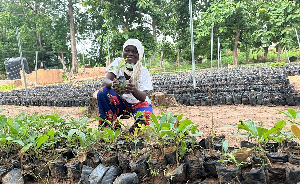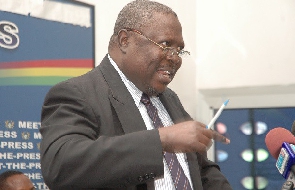Globally, one in every ten women lives in extreme poverty. The situation is no different in the Northern Savanna Zone (NSZ) of Ghana, which continues to face significant developmental challenges, particularly regarding multi-dimensional poverty, and low socio-economic status of women.
The United Nations Development Programme (UNDP), through several interventions including the Green Climate Fund’s $30m Ghana Shea Landscape Emission Reductions Project (GSLERP), is supporting local communities to change this narrative by fostering women's social and economic empowerment, in partnership with the Forestry Commission and the Global Shea Alliance.
Women's empowerment is crucial for attaining many of the Sustainable Development Goals (SDGs), including those related to food security, nutrition, health, climate resilience, and economic growth.
Through the GSLERP, UNDP shifts away from short-term, temporary measures to a more integrated, multi-stakeholder coordination of investments. Significant efforts are being pursued by UNDP and partners to enhance women's inclusion and participation in local development, recognizing the criticality of how empowerment, and improved livelihoods are central to community prosperity and sustainable development.
Supporting women in development through enhanced capabilities require the following actions:
Intentional Gender Planning
For development to appropriately consider and reflect the gender dynamics of a community, a gender diagnostic study or analysis is required, especially in the absence of such existing data that can provide the needed insight for gender-informed activities.
UNDP has supported several of such studies including a gender analysis of the Nationally Determined Contributions in water, waste, health, Transport, Disaster Risk Reduction, and Climate Service Centers.
Under the GSLERP project, a gender analysis and action plan have been prepared, with the intention to close gender gaps in access to and control over natural resources; improving women’s participation and decision making; and/or generating socio-economic benefits and services for women.
Through UNDP’s Social and Environmental standards, which is an integral part of UNDP’s quality assurance and risk management approach to programming, projects such as GSLERP do not only identify risks and associated management actions, but also provide positive enhancements in development interventions including for the vulnerable, mostly women, children, and persons with disability.
Women in Active Landscape Management Leadership
To foster inclusive natural resource management in Ghana, communities are engaged through the Community Resource Management Areas (CREMAs) programme. Governance and management of CREMAs are mediated by locally developed consensual constitutions which are backed by relevant district by-laws and management plans.
Under GSLERP, the participation of women in CREMA leadership is fostered through a minimum of 40:60 percentage ratio of women to men in leadership, an improvement over the initial usual baseline of zero. The participation of women in leadership influences community resource use plans from a dynamic perspective that favours community and family wellbeing, a critical objective of GSLERP.
Cooperatives
Cooperatives function as socio-economic currency by fostering relationships, trust, mutual aid, and shared prosperity, all of which contribute to the overall well-being and cohesion of communities. Advancing the adoption of cooperatives especially for women, does not only provide a stronger bargaining power for individuals in the group, but also promotes ownership, sustainability, and plays a pivotal role in poverty eradication, job creation, and transforms economic and social structures, including gender responsiveness.
With GSLERP’s execution of intervention programs through women’s cooperatives, aimed at increasing shea-related incomes by 30-50%, women are supported in securing fair earnings, gaining access to storage facilities, and establishing market access to larger/commercial shea offtakes.
Conclusion
Engaging and empowering women in GSLERP’s implementation is essential, including the ability to meet its aim of restoring 25,000 hectares of degraded forest reserves through the Modified Taungya System. The impact of GSLERP is evident in the success stories emerging from the NSZ where the project has provided the impetus and opportunities for women to be socially and economically empowered through targeted interventions and a commitment to gender equality.
UNDP will continue to work with its partners to ensure that women are not only beneficiaries but also key drivers of Ghana’s national priorities in the pursuit of sustainable development that leaves no one behind.
Opinions of Monday, 26 August 2024
Columnist: Samuel Danquah



















